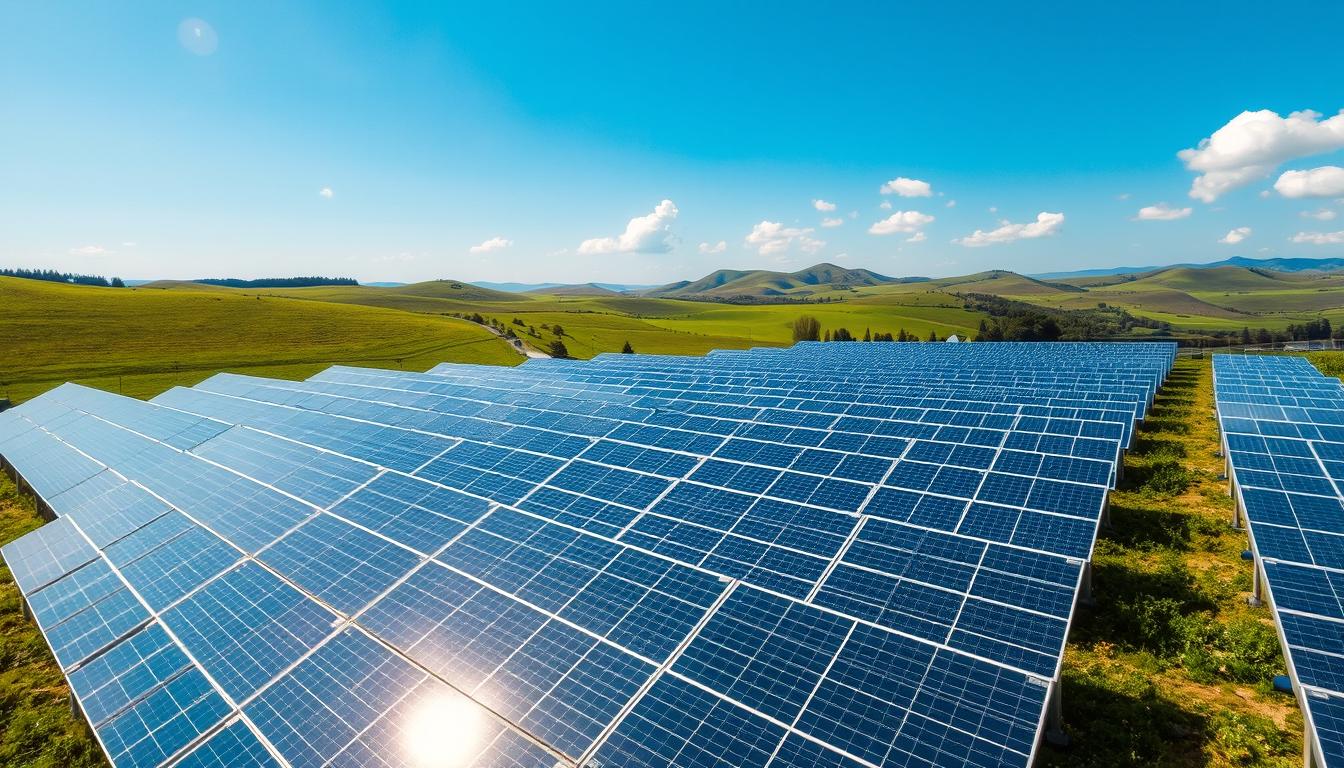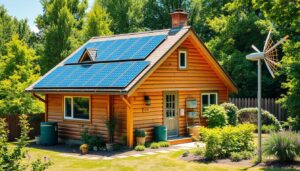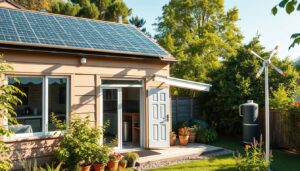I love sustainable living and renewable energy. Solar power is amazing. It lets us use the sun’s energy to power our homes and communities.
I started learning about solar power a few years ago. I wanted to cut down my carbon footprint. I was amazed by how much solar power has improved and how it can save money.
In this guide, we’ll explore how solar panels work. We’ll look at the science behind turning sunlight into electricity. You’ll learn about solar power systems, new solar panel designs, and more. This will help you decide if solar power is right for you.
Key Takeaways
- Solar panels work by converting sunlight into electricity through photovoltaic cells made primarily of silicon.
- The electrical current produced by solar panels is initially direct current (DC) and must be converted to alternating current (AC) for use in homes.
- Solar power systems include key components like solar panels, charge controllers, inverters, and storage batteries to collect, store, and utilize solar energy.
- Monocrystalline solar panels are the most efficient type, while polycrystalline and thin-film panels offer more cost-effective options.
- Government incentives and net metering programs can significantly offset the initial cost of installing a solar power system, making it a more accessible and financially viable option for homeowners.
Understanding Solar Cells: The Heart of Solar Panels
Solar panels have solar cells at their core. These cells are usually made from silicon wafers. They turn the sun’s energy into electrical current. This is called the photovoltaic effect.
The Solar Conversion Process Explained
When sunlight hits solar cells, it excites the electrons in silicon atoms. This makes the electrons move and creates an electrical current. The current is captured by metal plates on the cells.
The positive and negative layers in the cells work together. They make and send out direct current (DC) electricity. This is thanks to the solar arrays.
Capturing and Conducting Solar Power
- The photovoltaic effect lets solar cells turn sunlight into electricity.
- Silicon, a semiconductor, absorbs the sun’s energy and makes electricity.
- Conductive metal plates capture and send the solar-generated electricity.
- New technologies like multi-junction cells and perovskite materials make solar panels more efficient.
The magic of turning sunlight into electricity is key to solar panels. By knowing how solar cells work, we see the science and tech behind solar power.
How Solar Panels Generate Electricity
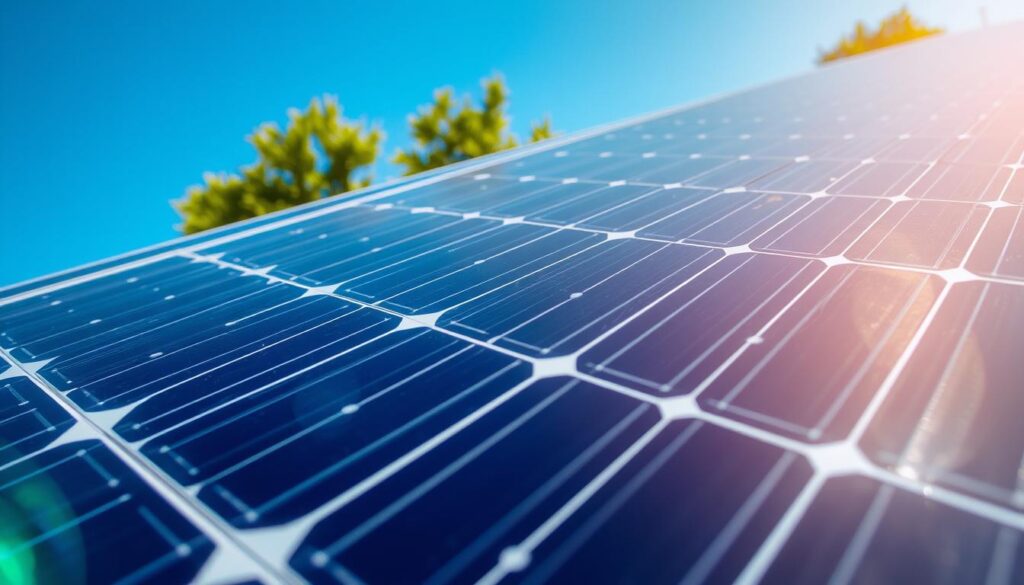
Solar panels use the sun’s power to make clean, renewable electricity. They do this thanks to special solar cells in each panel.
Absorbing Sunlight Efficiently
Most solar cells are made from silicon. This material turns sunlight into electrical energy. Monocrystalline silicon cells are more efficient than others.
Generating and Transmitting DC Power
When sunlight hits solar cells, it creates an electric field. This field makes an electrical current. The current is then sent through metal plates in the solar module.
Enhancing the Electrical Flow for Home Use
To use the DC power in homes, it needs to be changed to AC. Solar inverters do this. They make sure the power is stable and consistent.
Optimizing Power Output for Maximum Efficiency
Solar panels can turn sunlight into electricity. But, they work better with the right setup. Techniques like panel orientation and concentrated solar power help a lot.
Good solar cell design and smart power management make solar panels reliable. They give us a clean, sustainable electricity source for our homes and communities.
The Role of Solar Inverters in Power Conversion
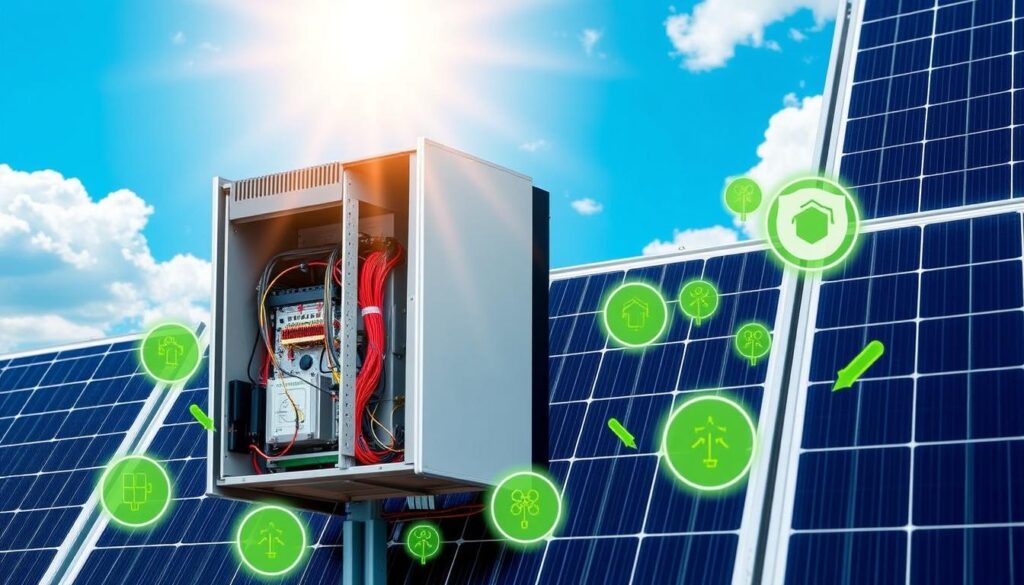
Solar inverters are key in using the sun’s power. They change solar energy into electricity for our homes and businesses.
Inverting DC to AC Power
Solar panels make direct current (DC) electricity from sunlight. But, most of our stuff uses alternating current (AC) power. Solar inverters change DC to AC power for us to use.
Synchronizing Power Waves for Stability
Solar inverters make sure the AC power they make matches the grid. They adjust phase, frequency, and voltage for a stable power flow.
Handling Power Fluctuations for Consistent Supply
The sun’s power changes during the day. Solar inverters smooth out these changes. They give us steady electricity for our needs.
Delivering Usable Power for Everyday Needs
Solar inverters make the sun’s energy usable for our devices and lights. They make sure we get the most from our solar panels.
In short, solar inverters are crucial for our solar energy future. They turn the sun’s power into electricity for us.
Storing Solar Power: How Batteries Work
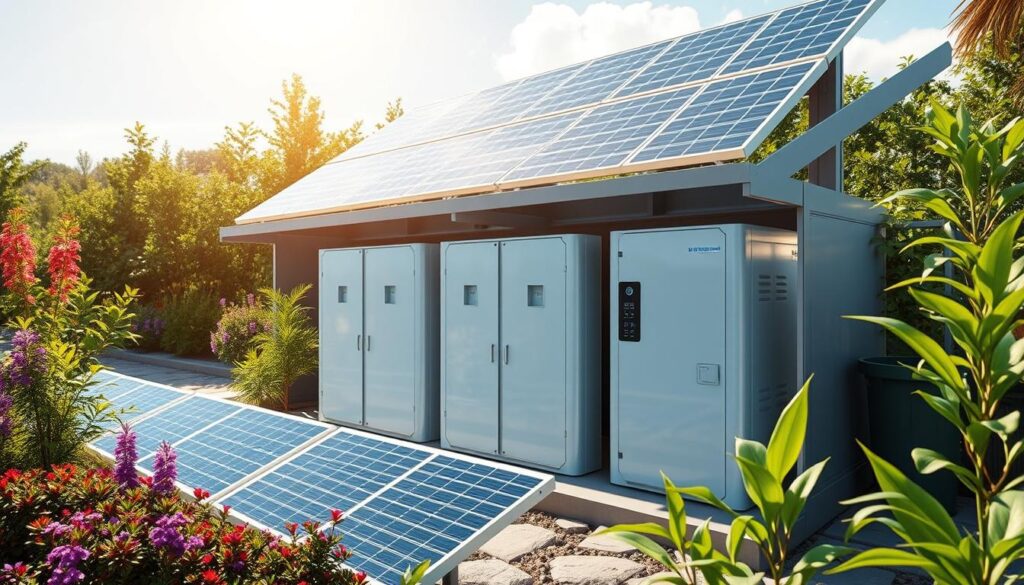
Solar power has changed how we get and use electricity. But what if the sun isn’t out? That’s when solar battery storage kicks in. It lets us save energy made when the sun is bright for later use.
Efficient Solar Charging Techniques
Solar batteries grab and save energy from your solar panels. They use smart silicon semiconductors and charging plans. This way, they turn direct current (DC) into alternating current (AC) power when you need it.
Holding Energy for Later Use
Storing extra solar energy in batteries lets you use renewable power even when it’s dark or sunny. It boosts your energy use and helps you live more sustainably. It also means you use less from the grid and can live off the grid.
Drawing from Solar Storage During Low Sunlight
If your solar panels can’t make enough power, your battery system helps out. It gives you the electricity you need, even when the sun isn’t bright.
Battery Cycling and Longevity
- Lead-acid batteries last 5-10 years, while lithium-ion ones last 10-15 years.
- Keeping batteries well-maintained is key to their long life and energy efficiency.
- New battery types, like nickel-cadmium, can last even longer for sustainable living.
Knowing how solar battery storage works lets people get the most from their systems. It makes sure they have a reliable and affordable renewable energy source for years.
Net Metering Explained: How Solar Credits Lower Your Bill
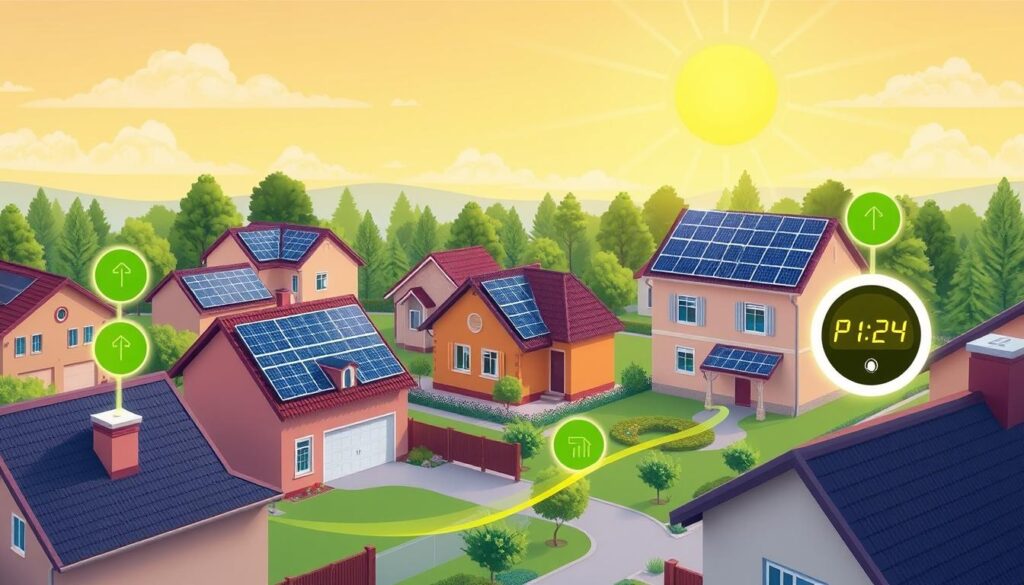
If you have solar panels at home, you need to know about net metering. It lets you send extra power back to the grid. You get credits on your bill for it. This way, you can save a lot on your energy costs.
The process is simple. A special meter tracks how much power you use and send back. This lets you use the credits to lower your bills. Over time, you can save a lot of money.
Net metering is not just about saving money. It also protects your rights and future savings. As rules change, net metering keeps your solar benefits going strong.
Net metering is key for anyone with solar panels. It helps you save money and help the planet. By using this program, you can enjoy its benefits for many years.
Conclusion: Reaping the Benefits of Solar Energy
Solar energy is changing how we power our homes and businesses. It uses advanced technology to turn sunlight into electricity. This technology is getting better all the time.
Using solar energy helps our planet by using less fossil fuels. It also saves money on energy bills. Plus, homes with solar panels can be worth more.
Government help and cheaper solar tech make it easier to use solar power. More people want homes that save energy. I believe solar energy will help us have a cleaner future.
FAQ
Q: How solar panels work?
A: Solar panels use special cells made from silicon. These cells turn sunlight into electricity. When sunlight hits the cells, it knocks electrons loose. This creates an electrical current.
The current is then captured by metal plates. This is how solar panels make electricity.
Q: What is the role of solar inverters in the power conversion process?
A: Solar inverters change direct current (DC) from solar panels into alternating current (AC). This AC is what homes and businesses use. Inverters keep the power stable and usable.
Q: How do solar batteries store excess energy generated by the panels?
A: Solar batteries save extra energy made by panels during sunny times. This energy is used when it’s not sunny or at night. The article talks about how batteries work and last long.
Q: How does net metering work, and how does it help lower energy bills?
A: Net metering lets solar panel owners send extra electricity back to the grid. They get credits on their bills. This way, they can use less energy from the grid and save money.
Q: What are the key components of solar panel technology?
A: Solar panel tech has photovoltaic cells, inverters, and batteries. Cells turn sunlight into electricity. Inverters change DC to AC for use at home. Batteries store extra energy for later use.
Q: What are the benefits of transitioning to solar energy?
A: Solar energy is good for the planet and saves money. It cuts down on fossil fuel use. It’s a smart, green way to get energy.

